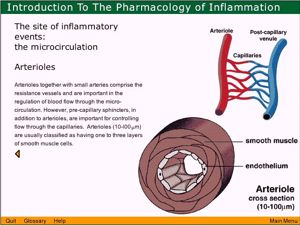Inflammation Pharmacology
By David Dewhurst, Susan Brain & Jake Broadhurst
| Record number: | e8b73 (legacy id: 5048) |
|---|---|
| Category: | Pathology - Pharmacology - Physiology |
| Type: | Computer Program |

A computer simulation of experiments to demonstrate the effects of pharmacological agents on the cutaneous inflammatory response in the anaesthetised rabbit.
This program simulates a range of experiments designed to demonstrate the action of inflammatory mediators and pharmacological agents on the in vivo inflammatory response in the anaesthetised rabbit. The program uses data obtained from actual experiments and is aimed at undergraduate students on courses in which pharmacology is a major component. It may be particularly useful for teaching students either to support laboratory practicals or, in those departments where lack of equipment and/or technical expertise precludes this, as a student-centered alternative.
Introduction and Methods sections combine text and high- quality colour graphics to describe the animal preparation, the methods employed to measure oedema formation (extravascular accumulation of 125I - albumin) and neutrophil accumulation, and to provide the student with the essential background information required to understand the how the inflammatory response is triggered, and the mechanisms involved.
The Experiments section allows the student to select, from a menu, to study the effects of the following agents on oedema formation (and where appropriate on neutrophil numbers) in normal rabbits:
- (1) a range of direct mediators of increased microvascular permeability [histamine, bradykinin, platelet activating factor (PAF), Substance P, leukotriene D4], either alone (dose-response relationships), in the presence of a vasodilator (PGE2) or with receptor antagonists;
- (2) a range of agents which cause inflammation principally via neutrophil accumulation [complement Factor C5a, cytokines interleukins IL-1 and IL-8, the bacterial peptide f-methyl-leucyl-phenylalanine (FMLP), leukotriene B4, Tumour Necrosis Factor (TNFalpha)], either alone (dose-response relationships) and in the presence of a vasodilator (PGE2). The effects of neutrophil depletion and the importance of adhesion molecules are also covered;
- (3) non-steroidal (local and systemic effects) and steroidal anti-inflammatory agents.
A section describing the results of selected experiments using sensitized rabbits is also included and covers the IgG (Reverse Passive Arthus response) and IgE response.
The results are presented in graphical form either as bar-charts or line graphs. The program contains numerous self-assessment exercises which demand interpretation of experimental data presented to them, and an understanding of the underlying inflammatory mechanisms. These student-centred activities make the program useful for self-directed learning or, in the ideal situation, it would be incorporated into a structured teaching programme and used with a teacher-designed workbook.
Please click here for more information.
ISBN: 1-874758-24-7
Language: English
Recommended System Requirements:
Safari 5.0 or later, Mozilla Firefox 4.0 or later, Google Chrome or Edge
Target Audience:
Particularly suitable for undergraduate students from a range of biological science, medical and health-related courses.
Price: £250 (multiuser, educational licence)
Product reviews Reviewed
Thanks for your feedback! Please note that we cannot reply to you unless you send us an email.
What are you looking for?
We value your feedback so we can improve the information on the page. Please add your email address if you would like a reply. Thank you in advance for your help.!
Please contact us by email if you have any questions.
